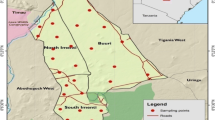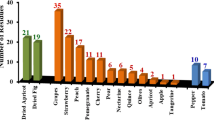Abstract
Turkey is one of the world’s largest producers and exporters of table grapes. Growing social concerns over excessive pesticide use have led to farming to move from conventional to organic practices. Table grapes were collected from 99 different farms in three Aegean regions. Pesticide residues were only detected in farms using conventional agriculture practices while no pesticides were detected in grapes from farms using organic or integrated pest management. A risk assessment model indicated that lambda-cyhalothrin posed the most significant risk at conventional farms.
Similar content being viewed by others
References
Ahmad, M., Sayyed, A. H., Saleem, M. A., & Ahmad, M. (2008). Evidence for field evolved resistance to newer insecticides in Spodoptera litura (Lepidoptera: Noctuidae) from Pakistan. Crop Protection, 27, 1367–1372.
Anastassiades, M., Lehotay, S. J., Stagnbaher, D., & Schenck, F. J. (2003). Quick, easy, cheap, effective (QueChERS) method for determining pesticide residue. Journal of AOAC International, 86, 412–431.
Anonymous (2005). NRDC sues EPA over private meetings with pesticide makers. Chemical Week, 167, 9–9.
Anonymous (2008). Aegean Exporters‘ Association report. Fact Sheets.
Angioni, A., Garau, A., Caboni, P., Russo, M. T., Farris, G. A., Zara, S., et al. (2005). Gas chromatographic ion trap mass spectrometry determination of zoxamide residues in grape, grape processing, and in the fermentation process. Journal of Chromatography A, 1097, 165–170.
Barlas, N., Cok, I., & Akbulut, N. (2006). The contamination levels of organochlorine pesticides in water and sediment samples in Uluabat Lake, Turkey. Environmental Monitoring and Assessment, 118, 383–391.
Carvalho, F. P. (2006). Agriculture, pesticides, food security and food safety. Environmental Science & Policy, 9, 685–692.
Cesnik, H. B., Gregorcic, A., & Cus, F. (2008). Pesticide residues in grapes from vineyards included in integrated pest management in Slovenia. Food Additives and Contaminants, 25, 438–443.
Civelek, H. S., Yoldas, Z., & Ulusoy, M. R. (2004). Seasonal population trends of Liriomyza huidobrensis (Blanchared, 1926) (Diptera: Agromyzidae) on cucumber (Cucumis sativus L.) in Western Turkey. Journal of Pest Sciences, 77, 85–89.
Cunha, S. C., Lehotay, S. J., Mastovska, K., Fernandes, J. O., Beatriz, M., & Oliveira, P. P. (2007). Evaluation of the QuEChERS sample preparation approach for the analysis of pesticide residues in olives. Journal of Separation Science, 30, 620–632.
Dasgupta, S., Meisner, C., & Wheeler, D. (2007). Is environmentally friendly agriculture less profitable for farmers? Evidence on integrated pest management in Bangladesh. Review of Agricultural Economics, 29, 103–118.
Doymaz, I., & Pala, M. (2002). The effects of dipping pretreatments on air-drying rates of the seedless grapes. Journal of Food Engineering, 52, 413–417.
European Commission Health (2005). Pesticides EU-MRL Regulation (EC) No 396/2005.
Gonzalez, C. F., Otero, R. R., Grande, B. C., & Gandara, J. S. (2003). Determination of fungicide residues in white grapes for winemaking by gas chromatography with mass spectrometric detection and assessment of matrix effects. Journal of AOAC International, 86, 1008–1014.
Kolankaya, D. (2006). Organochlorine pesticide residues and their toxic effects on the environment and organisms in Turkey. International Journal of Environmental Analytical Chemistry, 86, 147–160.
Morales, H. (2002). Pest management in traditional tropical agroecosystems: lessons fro pest prevention research and extension. Integrated Pest Manage Review, 7, 145–163.
Navarro, S., Oliva, J., Barba, A., Navarro, G., Garcia, M. A., & Zamorano, M. (2000). Evolution of chlorpyrifos, fenarimol, metalaxyl, penconazole, and vinclozolin in red wines elaborated by carbonic maceration of Monastrell grapes. Journal of Agricultural and Food Chemistry, 48, 3537–3541.
Oliva, J., Navarro, S., Barba, A., & Navarro, G. (1999). Determination of chlorpyrifos, penconazole, fenarimol, vinclozolin and metalaxyl in grapes, must and wine by on-line microextraction and gas chromatography. Journal of Chromatography A, 833, 43–51.
Oliva, J., Barba, A., Vela, N., Melendreras, F., & Navarro, S. (2000). Multiresidue method for the rapid determination of organophosphorus insecticides in grapes, must and wine. Journal of Chromatography A, 882, 213–220.
Oztekin, S., Bascetincelik, A., & Soysal, Y. (1999). Crop drying program in Turkey. Renew Energy, 16, 789–794.
Poulsen, M. E., Hansen, H. K., Sloth, J. J., Christensen, H. B., & Andersen, J. H. (2007). Survey of pesticide residues in table grapes: determination of processing factors, intake and risk assessment. Food Additives and Contaminants, 24, 886–895.
Rehber, E., & Turhan, S. (2002). Prospects and challenges for developing countries in trade and production of food and fibers. The case of Turkey. British Food Journal, 104, 371–390.
Steiner, M., Gerbl-Reiger, S., Schaff, P., & Parlar, H. (2007). Current situation of the application and identification of pesticides in EU bordering countries with respect to the implementation of a monitoring system. Fresenius Environmental Bulletin, 16, 443–451.
Turgut, C. (2003). The contamination with organochlorine pesticides and heavy metals in surface water in Kucuk Menderes River in Turkey, 2000–2002. Environment International, 29, 29–32.
Turgut, C. (2006). The growth stability and sensitivity of parrotfeather to a reference toxicant (3,5-dichlorphenol) throughout a 1-year period. Fresenius Environmental Bulletin, 15, 462–464.
Turgut, C. (2007a). The impact of pesticides toward parrotfeather when applied at the predicted environmental concentration. Chemosphere, 66, 469–473.
Turgut, C. (2007b). Organochlorine insecticide residues in Turkish mineral waters. Fresenius Environmental Bulletin, 16, 252–255.
Turgut, C., & Fomin, A. (2002). Residues of selected pesticides in the Kucuk Menderes River in Turkey. Zeitschrift für PflKrankh und Pflschutz, XVIII, 1053–1057.
USFDA (2005). US Food and Drug Administration, compliance program guidance manual feed contaminants program, govt document 7371.001, Washington DC.
Wood, R., Lenzen, M., Dey, C., & Lundie, S. (2006). A comparative study of some environmental impacts of conventional and organic farming in Australia. Agricultural systems, 89, 342–348.
Author information
Authors and Affiliations
Corresponding author
Rights and permissions
About this article
Cite this article
Turgut, C., Ornek, H. & Cutright, T.J. Determination of pesticide residues in Turkey’s table grapes: the effect of integrated pest management, organic farming, and conventional farming. Environ Monit Assess 173, 315–323 (2011). https://doi.org/10.1007/s10661-010-1389-4
Received:
Accepted:
Published:
Issue Date:
DOI: https://doi.org/10.1007/s10661-010-1389-4




